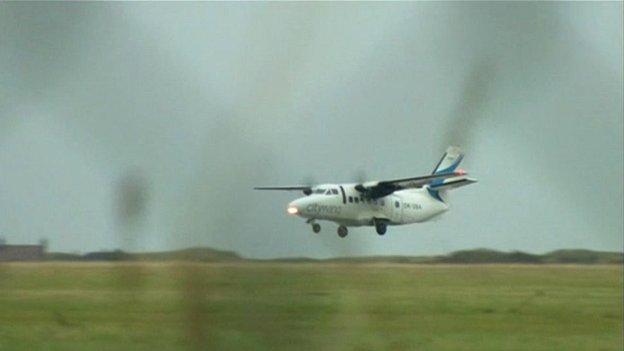Blackpool Airport's highs and lows recalled
- Published

A Vulcan Bomber once guarded the entrance to the airport
When the last passenger flight takes off from Blackpool Airport, it will mark the end of an era for a seaside airstrip which has tasted showbiz razzamatazz but also tragedy.
Although it will continue to operate flights to the Irish Sea gas rigs, and see corporate clients come and go, its days as a regional passenger airport appear to be over.
The site's aviation history dates back more than a century and in its early years, Blackpool hosted regular air shows, an RAF presence and local pleasure flights between the wars.
In 1909, more than 200,000 spectators watched Frenchman Henri Farman take to the air at Squires Gate at a meeting of the Aero Club of the United Kingdom.
But it was 1946 before flights carrying paying passengers took off in earnest.
'Pap free zone'
Services began to and from the Isle of Man and over the years it has seen short haul holiday flights to countries such as Spain and the former Yugoslavia.
By 1950, 25,000 passengers were passing through the airport to travel to Manchester, London, Leeds, Birmingham, Southport and Glasgow.

The Queen, Rod Stewart and Margaret Thatcher have all taken advantage of Blackpool's quiet airport
According to Stuart Menzies, who manages a fleet of aircraft for both commercial and private operations from the site, the airport has been quietly popular with a string of VIPs as well as royalty.
"It is a small airport and they can arrive without encountering the paparazzi," said Mr Menzies, who has worked at the airport for 28 years.
"Very early on I remember the Sultan of Brunei came through on his way to the Lake District.
"The Queen usually arrives once a year, very quietly, when she is travelling to see the Duke of Westminster."
The most recent was pop legend Rod Stewart, who landed at the airport ahead of his summer gig at Blackpool FC.

The Big One's parts were stored at the airport
In the 1983 General Election campaign, Tory Prime Minister Margaret Thatcher was spirited into the Fylde Coast via the airport before a high-security drive down the promenade to Fleetwood for one of her final election rallies.
But the link with "Maggie" does not end there.
Roller coaster
Pilot Brian Bateson, a flying instructor based at the airport, towed a banner from his plane with the words: "Happy Birthday Maggie" during the 1981 Tory Party conference.
Two years later, he created an airport landmark buying a Vulcan bomber and placing it at the entrance, where it stayed until it was sold on e-Bay in 2004.
The airport has also been put to a variety of uses such as the time in the early 90s when it resembled a giant model-maker's bedroom storing sections of the Big One roller coaster before its construction at the nearby Blackpool Pleasure Beach.

Amy Johnson made her last flight from Blackpool Airport
The same ride became the back drop for the 2009 Blackpool Air Show which celebrated 100 years of aviation on the site.
Its closure has been described as a blow to the town but the airport has known darker days.
In 1941, Britain's most famous female aviator Amy Johnson set off from Blackpool for RAF Kidlington in Oxfordshire on what proved to be her final and fateful flight.
The pilot, who found fame in 1930 as the first woman to fly solo to Australia, was a member of the Air Transport Auxiliary which flew aircraft from factories to RAF bases.
The airport is on a road named after the Hull-born pioneer, whose body was never recovered after her crashed plane was found in the Thames Estuary.
It was also the airport's grim task to receive bodies from tragic deaths at sea such as the helicopter, carrying five rig workers and two crew, which crashed in Morecambe Bay in 2006.
The aircraft took off from Blackpool Airport and was ferrying Centrica staff from gas platforms in the bay.

Grim cargoes have landed at the airport.
The airport's final chapter was written in August when current owners Balfour Beatty put it up for sale after several years of losses.
But no buyer has been found and the airport is due to close later.
The final scheduled flight from Blackpool was made to the Isle of Man, at 17:00 BST.
- Published15 October 2014

- Published14 October 2014

- Published7 October 2014
